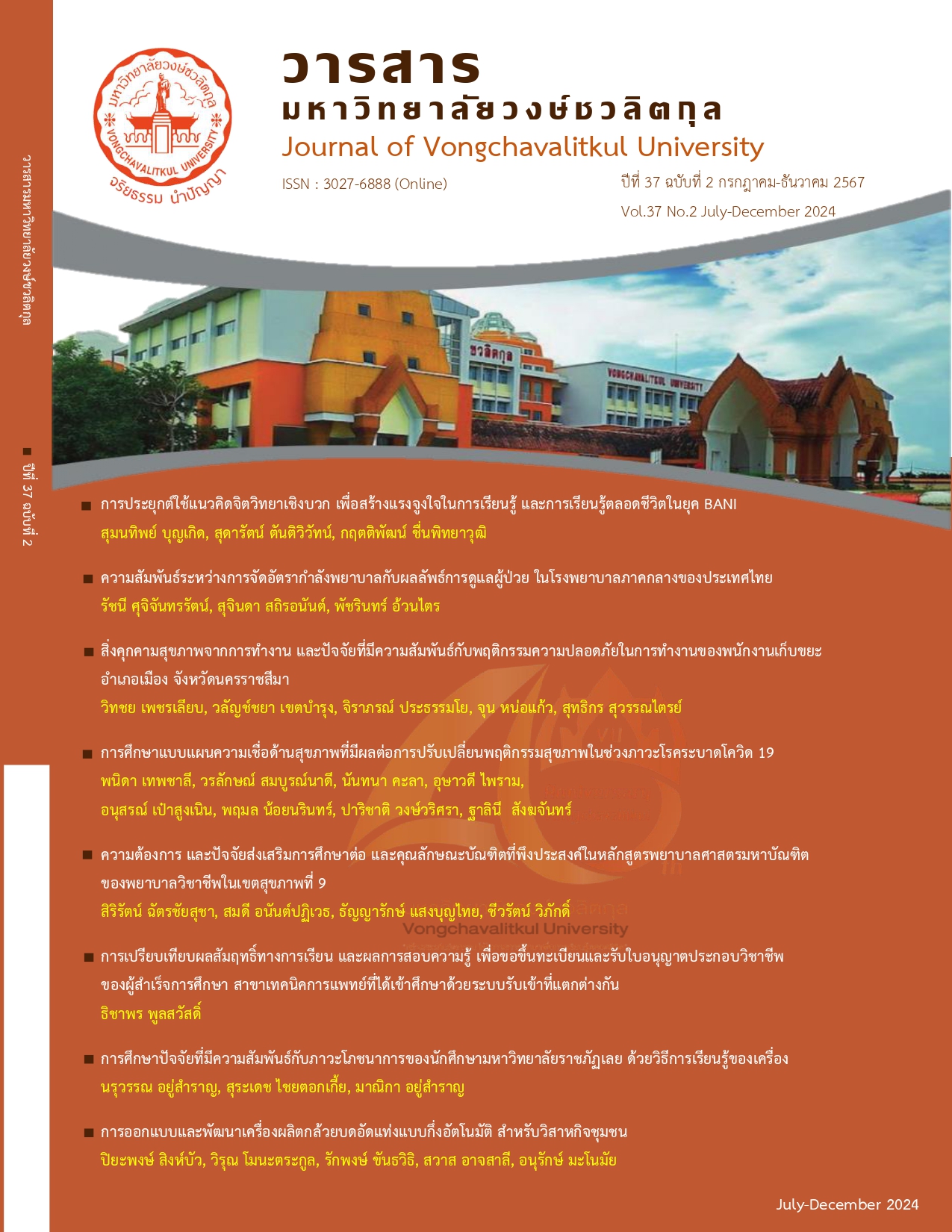The ความสัมพันธ์ระหว่างการจัดอัตรากำลังพยาบาลกับผลลัพธ์การดูแลผู้ป่วย ในโรงพยาบาลภาคกลางของประเทศไทย
คำสำคัญ:
อัตรากำลังพยาบาล, การติดเชื้อในโรงพยาบาล, วันนอนในโรงพยาบาล, การเกิดแผลกดทับ, การกลับเข้ารับการรักษาซ้ำบทคัดย่อ
วัตถุประสงค์: เพื่อศึกษาความสัมพันธ์ของการจัดอัตรากำลังพยาบาลกับผลลัพธ์การดูแลผู้ป่วยในโรงพยาบาลภาคกลาง ของประเทศไทย
วิธีการวิจัย: เป็นการวิจัยเชิงพรรณาแบบวิเคราะห์ความสัมพันธ์ ศึกษาในหอผู้ป่วยผู้ใหญ่ 74 แห่ง โรงพยาบาลภาคกลางของประเทศไทย เก็บรวบรวมข้อมูลจากฐานข้อมูลของโรงพยาบาล วิเคราะห์ความสัมพันธ์ของตัวแปรอัตรากำลังพยาบาลกับผลลัพธ์ที่เกิดในผู้ป่วย โดยใช้สถิติสเพียร์แมนแรงค์
ผลการวิจัย: ผลการวิเคราะห์ความสัมพันธ์ที่สำคัญพบว่า 1) ระดับความเจ็บป่วยมีความสัมพันธ์ทางบวกอย่างมีนัยสำคัญทางสถิติกับชั่วโมงการพยาบาลที่ผู้ป่วยได้รับต่อคนต่อวัน (NHPPD) และร้อยละของพยาบาลวิชาชีพ (%RN) (r= 0.384 p<.01, r= 0.331, p<.01 ตามลำดับ) 2) อัตราตายและการเกิดแผลกดทับมีความสัมพันธ์ทางบวกอย่างมีนัยสำคัญกับ NHPPD (r = 0.426, p< .01; r = 0.328, p< .01 ตามลำดับ) 3) การกลับเข้ารับการรักษาซ้ำมีความสัมพันธ์ผกผันอย่างมีนัยสำคัญกับ %RN (r = -0.263, p< .05) 4) การติดเชื้อในโรงพยาบาลของผู้ป่วยที่ใส่เครื่องช่วยหายใจ (VAP) และผู้ป่วยที่คาสายสวนปัสสาวะ (CAUTI) มีความสัมพันธ์ทางบวกกับชั่วโมงการพยาบาลที่ไม่ได้รับ (Short NHPPD) อย่างมีนัยสำคัญ (r= 0.275, p<.05, r= 0.369, p<.01 ตามลำดับ)
ผลการศึกษาชี้ให้เห็นถึงความสัมพันธ์ที่สำคัญระหว่างการจัดสรรบุคลากรพยาบาลกับผลลัพธ์ของผู้ป่วย โดยเน้นย้ำถึงความสำคัญของการจัดสรรบุคลากรในระดับที่เพียงพอและสัดส่วนของพยาบาลวิชาชีพในการยกระดับความปลอดภัยของผู้ป่วยและคุณภาพการดูแลในโรงพยาบาลระดับตติยภูมิ
References
Aiken, L., Ceron, C., Simonetti, M., Lake, E., Galiano, A., & Garbarini, A., et al. (2018). Hospital nurse staffing and patient outcomes. Revista Medica Clinica Las Condes, 29(3), 322-327.
Aiken, L., Clarke, S., Sloane, D., Sochalski, J., Silber, J. (2002). Hospital nurse staffing and patient mortality, nurse burnout, and job satisfaction. JAMA, 288, 1987-1993.
American Nurses Association (ANA). (1996). Nursing quality indicators: Definitions and implications: Patient safety nursing quality. Washington, DC: Author.
American Nurses Association (ANA). (2007). National Databased for Nursing Quality Indicators (NDNQI). Retrieved from htpps://www.ncvhs.gov/wp-content/uploads/2014/05/070619p8.pdf.
Chitpakdee, B., Kunaviktikul, W., Srisaphan, W., & Akkadechanunt, T. (2008). Nurse staffing and adverse patient outcomes. Chiang Mai University Journal of Natural Sciences, 7(1), 59-71.
Cho, E., Chin, D. L., Kim, S., Kong, O. (2016). The relationships of nurse staffing level and work environment with patient adverse events. Journal of Nursing Scholarship, 48(1),74-82. https://doi.org/10.1111/jnu.12183
Cho, E., Sloane, D. M., Kim, E., Kim, S., Choi, M., Yoo, I. Y., et al. (2015). Effects of nurse staffing, work environments, and education on patient mortality: An observational study. International Journal of Nursing Studies, 52(2), 535-542.
Choi, J., & Staggs, V. (2014). Comparability of nurse staffing measures in examining the relationship between RN staffing and unit-acquired pressure ulcers: A unit-level descriptive, correlational study. International Journal of Nursing Studies, 51(10), 1344-1352. https://doi.org/10.1016/ j.ijnurstu.2014.02.011
Dall’Ora, C., Saville, C., Rubbo, B., Turner, L., Jones, J., & Griffiths, P. (2022). Nurse staffing levels and patient outcomes: A systemic review of longitudinal studies. International Journal of Nursing Studies, 134. https://doi.org/10.1016/j.ijnurstu. 2022.104311
Donabedian, A. (1992). The role of outcomes in quality assessment and assurance. Quality Review Bulletin, 18(11), 356-360. https://doi.org/10.1016/s0097-5990 (16)30560-7
Donabedian, A. (1998). The quality of care: How can it be assessed? JAMA, 260(12), 1743-1748. https://doi.org/10.1001/jama.260. 12.1743
Giuliano, K., Danesh, V., & Funk, M. (2016). The relationship between nurse staffing and 30-day readmission for adults with heart failure. Journal of Nursing Administration, 46(1), 25-29. https://doi.org/10.1097/NNA.0000000000000289
He, J., Staggs, V. S., Berquist-Beringer, S., & Dunton, N. (2016). Nurse staffing and patients outcomes:
A longitudinal study on trend and seasonality. BMC Nursing, 15, 60-70.
Khamsribut, P. (2010). Situation analysis of nurse staffing in pediatric intensive care unit in a university hospital. (Master Thesis, Graduate School, Mahidol University, Bangkok).
Kouatly, I. A., Nassar, N., Nizam, M., & Badr, K. L. (2018). Evidence on nurse staffing ratios and patient outcomes in a low-income country: Implications for future research and practice. Worldviews on Evidence-Based Nursing, 15(5), 353-360.
Lasater, K. B., Aiken, L. H., Sloane, D., French, R., Martin, B., Alexander, M., et al. (2021). Patient outcomes and cost savings associated with hospital safe nurse staffing legislation: An observational study. BMJ Open, 11(12). https://doi.org/10.1136/bmjopen-2021-052899
Morioka, N., Okubo, S., Moriwaki, M., & Hayashida, K. (2022). Evidence of the association between nurse staffing levels and patient and nurse’s outcomes in acute care hospitals across Japan: A scoping review. Healthcare, 10(6), 1052-1064. https://doi.org/10.3390/ healthcare10061052
Pongpattaraporn, R. (2010). Association between nurse staffing and pressure ulcer. (Master Thesis in Nursing Administration, Sukhothai Thammathirat Open University).
(in Thai)
Sawaengdee, K., Jaichuen, W., & Daecha, N. (2019). Manpower reform plan and health mission of the Ministry of Public Health. Nonthaburi: Suetawan. (in Thai)
Sportsman, S. (2023). Staffing & scheduling. In P. S. Yoder-Wise & S. Sportsman (Eds.), Leading and managing in nursing (8th ed., pp. 244-267). St. Louis: Elsevier.
Staggs, V. S., & Dunton, N. (2014). Associations between rates of unassisted inpatient falls and levels of registered and non-registered nurse staffing. International Journal for Quality in Health Care, 26(1), 87-92. https://doi.org/10.1093/ intqhc/mzt080
Sujijantararat, R. (2019). Nurse staffing and scheduling. In R. Sukadecha & R. Sujijantararat (Eds.), Nursing administration (pp. 139-162). Nakhon Ratchasima: Somboon Publishing. (in Thai)
Sujijantararat, R., Booth, Z. R., & Davis, L. L. (2006). Nosocomial urinary tract infection: Nursing sensitive quality indicator in a Thai hospital. Journal of Nursing Care Quality, 20(2), 134-139.
Sujijantararat, R., Chansiri, K., Sukadaecha, R., Sumdangrith, P., & Wipak, C. (2023). The relationship between nurse staffing and nosocomial infection outcome in Central Thailand hospitals. Princess Naradhiwas University Journal, 15(2), 118-135. (in Thai)
Sujijantararat, R., Thepna, A., & Hankunasets, W. (2018). Nurse staffing and nosocomial infection outcome. Journal of Nursing Siam University, 19(37), 6-21. (in Thai)
Twigg, D. E., Kutzer, Y., Jacob, E., & Seaman, K. (2019). A quantitative systematic review of the association between nurse skill mix and nursing-sensitive patient outcomes in the acute care setting. Journal of Advanced Nursing, 75, 3404-3423. https://doi.org/10.1111/ jan.14194
Van, T., Annis, A. M., Yosef, M., Robinson, C. H., Duffy, S. A., & Li, Y. F., et al. (2020). Nurse staffing and healthcare-associated infections in a national healthcare system that implemented a nurse staffing directive: Multi-level interrupted time series analyses. International Journal of Nursing Studies, 104, 103531. https://doi.org/10.1016/ j.ijnurstu.2020.103531
Yosthong, D. (2019). Nursing shortage and management: Personal level management. Journal of Nursing Siam University, 20(38), 134-143.
(in Thai)
Downloads
เผยแพร่แล้ว
How to Cite
ฉบับ
บท
License
Copyright (c) 2024 วารสารมหาวิทยาลัยวงษ์ชวลิตกุล

This work is licensed under a Creative Commons Attribution-NonCommercial-NoDerivatives 4.0 International License.





